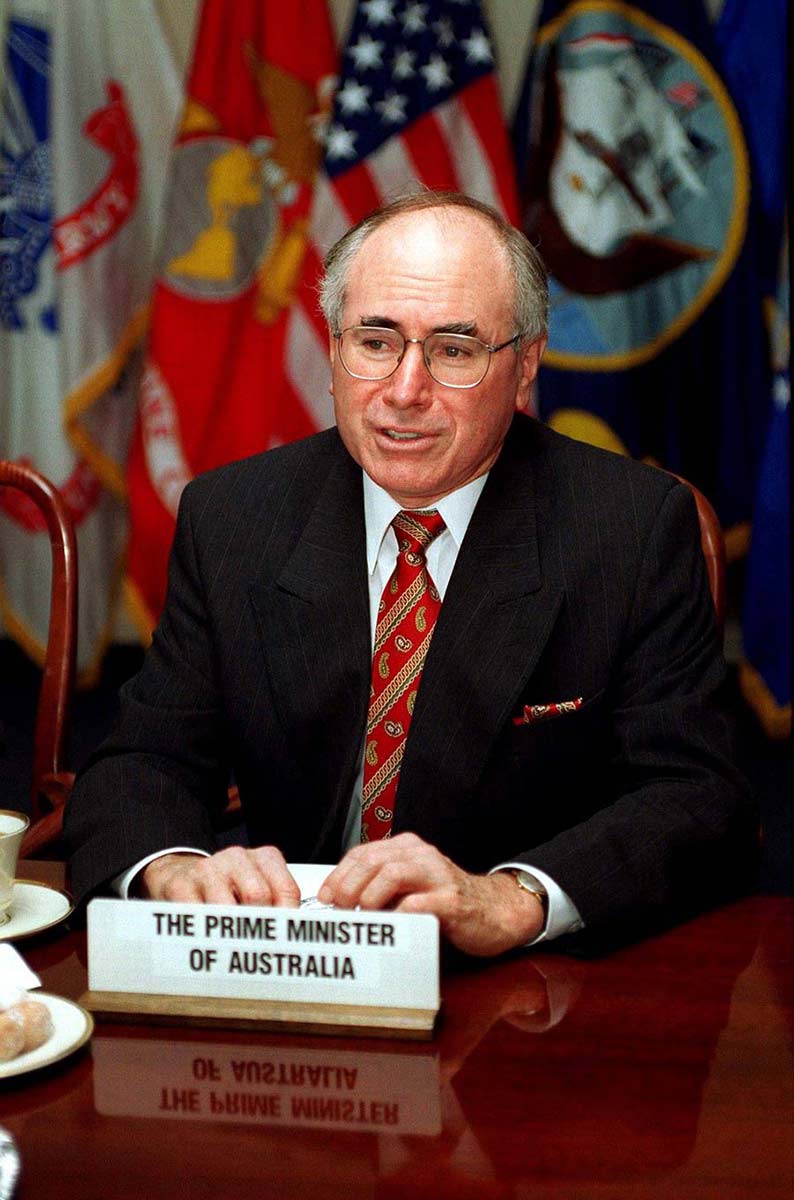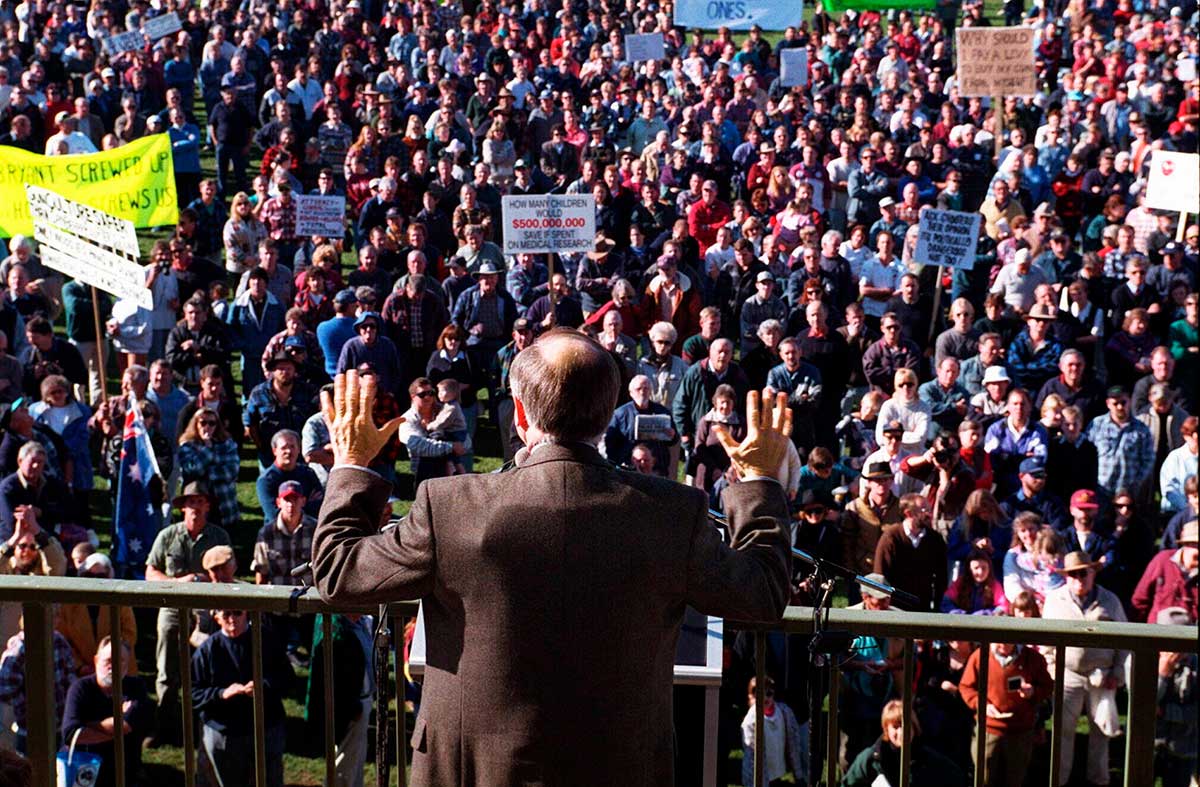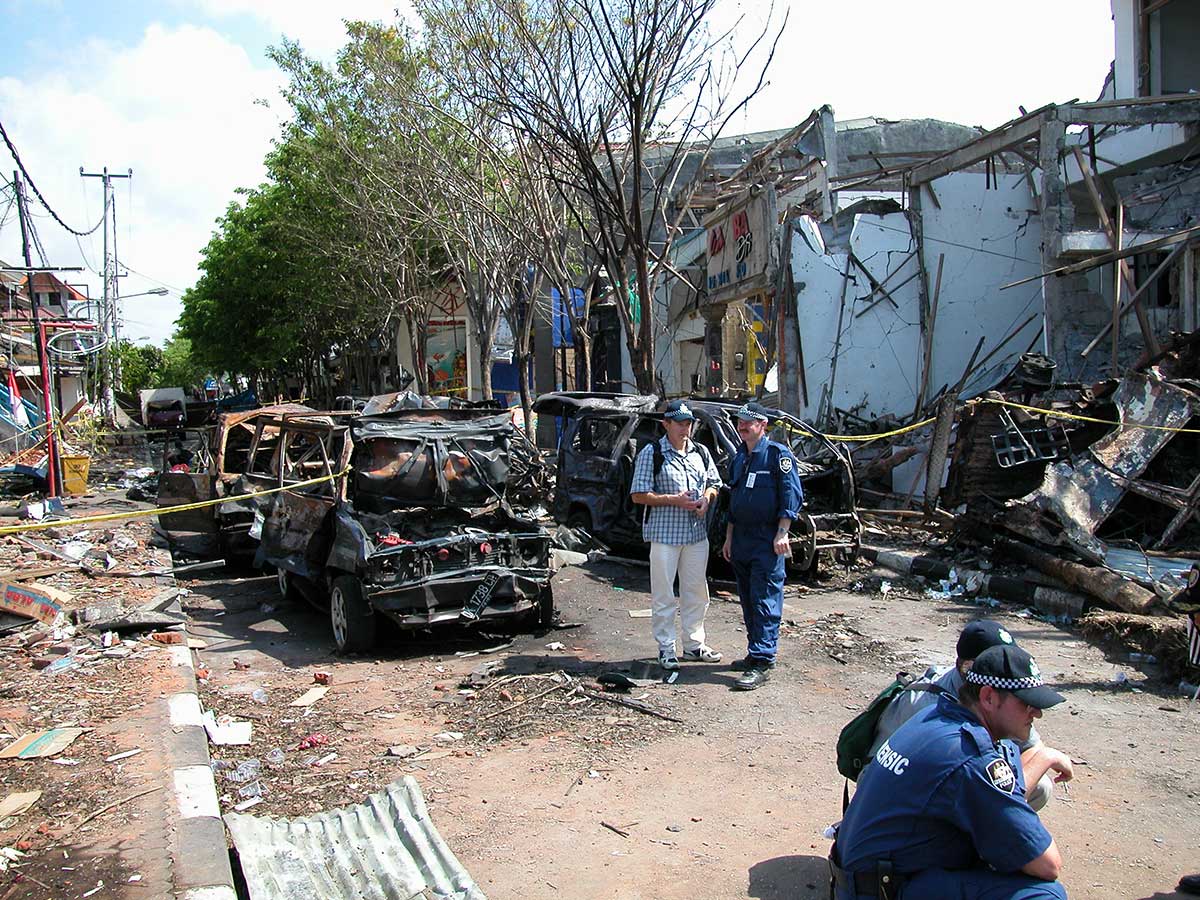Australia’s 25th Prime Minister

11 March 1996 to 3 December 2007
John Howard waited a long time to become Prime Minister. By the time he won the job, he had been in parliament for 22 years.
Howard became Australia’s second-longest-serving Prime Minister, and during his term in office achieved nationwide gun safety legislation and significant reforms in industrial relations and taxation.
After 11 years in office, Howard became the second Prime Minister to lose his seat in the House of Representatives while still serving as Prime Minister.
Howard's beginnings
John Winston Howard was born in Earlwood in Sydney on 26 July 1939. He grew up in this south-western industrial suburb, attending the local government primary school and later Canterbury Boys’ High School.
His father, a garage proprietor, influenced his emerging political and economic views, impressing on him the importance of small business as an employment provider.
After studying law at the University of Sydney, Howard graduated in 1961, and then practised as a solicitor for the next 12 years. A committed Liberal Party member, he was soon deeply involved in its organisation. He joined the party’s New South Wales State Executive in 1963, and served as State Vice-President of the party from 1972 to 1974.
In 1971 Howard married Janette Parker, and they had a daughter and two sons.
Howard's entry into federal politics
John Howard entered the House of Representatives as Liberal member for the suburban Sydney seat of Bennelong at the general elections on 18 May 1974.
Howard first became a minister following the election of the coalition government of Malcolm Fraser in December 1975, taking on the business and consumer affairs portfolio, which he held until 1977.
From May to December 1977 he served as Minister Assisting the Prime Minister and from July, as Minister for Special Trade Negotiations. In November that year, a month before the next federal elections, he was appointed Treasurer.
He held the position for more than five years, until the Fraser government lost office with the election of the Labor government led by Bob Hawke on 5 March 1983.
During the following 13 years of Labor government, Howard occupied a series of key positions in the shadow ministry. He was Shadow Treasurer and Deputy Liberal Party Leader (1983–1985) before replacing Andrew Peacock as Leader of the Opposition on 5 September 1985.
The change in leadership, and the continuing Howard–Peacock rivalry, signified the new ascendancy of supporters of a ‘dry’ or ‘economic rationalist’ philosophy within the Liberals over those favouring a ‘wet’ ideology more oriented towards social justice and ‘small-l’ liberal concerns.
Howard led the Liberal–Country Party coalition to a narrow loss at the next federal election in July 1987. The coalition’s prospects of an electoral victory over Labor had been severely damaged by the failed attempt of Queensland National Party Premier, Johannes Bjelke-Petersen, to enter federal parliament and seek the prime ministership.
Howard retained leadership of the opposition for nearly two more years, but the Howard–Peacock rivalry smouldered. It erupted again in May 1989, when Peacock secured sufficient votes to regain the Liberal leadership from Howard in May 1989.
Howard spent the next five years, from 1989 to 1995, filling a series of shadow ministry portfolios and other opposition positions: Shadow Minister for Industry, Technology and Communications; Shadow Minister Assisting the Leader on the Public Service; Chairman of the Manpower and Labour Market Reform Group; Shadow Minister for Industrial Relations; and Manager of Opposition Business in the House.
Following the resignation of Alexander Downer as Opposition Leader in January 1995, and with the Liberal party in disarray, Howard secured the position of leader for the second time.
With little more than a year before the next federal elections were due, Howard set about vigorously attacking the Labor government led by Paul Keating, mainly on its record of economic management.
Under his revitalised leadership, the Opposition coalition began campaigning on the promise of drastically reducing the Commonwealth’s increasingly heavy debt burden.
Prime Minister John Howard
At the federal election on 2 March 1996 the Liberal–National Party coalition under Howard was swept into power with an enormous majority in the House of Representatives.
Soon after, and claiming the government had been left with a ‘black hole’ of debt by Labor, he promised to reduce government expenditure by $8 billion over the next three years. This pledge was to continue guiding his government’s economic policies.
Only three weeks after Howard took office, a gunman murdered 35 people at Port Arthur, Tasmania. The massacre provoked national debate about private gun ownership, especially automatic weapons. Within weeks, Australian Prime Minister John Howard implemented critical changes to gun safety legislation with bipartisan state, territory and Commonwealth support.
During his time as Prime Minister, Howard won the general elections on 3 October 1998, 10 November 2001 and 9 November 2004. After the 2004 election, the government parties gained a majority in the Senate for the first time since 1981.
During his time as Prime Minister, Howard implemented many government policies including:
- After the High Court’s 1996 ‘Wik’ decision on Indigenous people’s ability to enter leasehold land where they had customary usage rights, the government legislated to restrict their access and confirm the leaseholders’ title.
- Legislation to replace industry-wide industrial agreements on wages and work conditions with workplace agreements between individual workers and employers. The government’s determination to eliminate compulsory trade union membership and secure waterfront reform was severely tested in a long-running waterfront dispute during 1998, when a stevedoring company locked out unionists from its wharves and employed non-union labour instead.
- In 1998 the government introduced a ‘work for the dole’ scheme that linked unemployment relief to recipients’ willingness to work at assigned tasks.
- Establishment of a part-appointed, part-elected convention on the issue of Australia becoming a republic. This body met during February 1998 and the government put the convention’s proposals to the public in a referendum in November 1999. The referendum, along with a proposal sponsored by the Prime Minister to add a Preamble to the Australian Constitution, was rejected.
- Funding environmental protection by privatising partial ownership of its communications corporation, Telstra. One third of Telstra was sold in 1996 and the government then moved to sell all of Telstra in 1998. The Senate eventually accepted the bills permitting the partial (49.9 per cent) sale of Telstra in June 1999.
- Reform of the taxation system through introduction of a tax on consumption – the Goods and Services Tax, or GST. The government announced this new tax proposal prior to the 1998 election, and, supported by the Australian Democrats who had demanded modification of the GST bills, succeeded in persuading the Senate to accept GST legislation in June 1999.
- During the early years of Howard’s government, foreign affairs and immigration policies were influenced by events such as the arrival of immigrants and asylum seekers by boat, communal violence in Indonesia and Malaysia, the continuing warfare in the Balkans following the collapse of the former Communist state of Yugoslavia, the vote for independence in East Timor and attempts to find a peaceful solution to the troubles of Northern Ireland.
- A focus on domestic and regional security in response to the terrorist attack in the United States on 11 September 2001 and the bombing of a nightclub in Bali, Indonesia in October 2002. This included increased funding for intelligence agencies, aviation, maritime and border security and regional counter-terrorism measures. As part of the ‘war on terror’, Howard committed troops to Afghanistan from 2002 and to Iraq from 2004.
- Abolition of the Aboriginal and Torres Strait Islander Commission (ATSIC) in June 2004 and transfer of ATSIC programs to mainstream agencies. From 2005 shared responsibility agreements were introduced in which Indigenous communities defined the changes they would implement in return for government funding.
- Negotiation of a free trade agreement with the United States in 2004, and pursuit of closer economic agreements with countries in the Asia-Pacific region. A closer commitment to regional neighbours also led to Australia lending significant military and police assistance to East Timor, Solomon Islands and Tonga, and continued assistance to Papua New Guinea.
- Further changes to industrial relations in 2006 through the introduction of WorkChoices. This created a national workplace relations system, significant changes to unfair dismissal laws and introduction of the Australian Fair Pay Commission.
- Establishment of the National Water Commission in 2006 and, in 2007, the National Plan for Water Security in response to the severe and prolonged drought. Pressure to become a signatory to the Kyoto Protocol in order to achieve specified targets for reducing greenhouse gas emissions was resisted by the government, but it did commit funds to research on renewable energy (for example, the contribution of nuclear energy to Australia’s long-term energy needs) in the context of increased awareness of climate change.
At the general election on 24 November 2007, Howard’s Liberal-National coalition was defeated by the Labor Party led by Kevin Rudd. Howard was the second-longest-serving Prime Minister after Robert Menzies, and became only the second Prime Minister to lose his own seat.
Legislation passed under Howard
- National Firearms Program Implementation Act 1996, which funded the gun buy-back scheme. The Act provided for financial assistance to the States and Territories to compensate firearms owners and dealers.
- The Telstra (Dilution of Public Ownership) Act 1996 provided for the sale of up to one third of the Commonwealth’s equity in Telstra Corporation Limited. This was followed by the Telstra (Further Dilution of Public Ownership) Act 1999.
- The Workplace Relations and Other Legislation Amendment Act 1997 amended the provisions of the Workplace Relations Act 1996 relating to certified agreements. Further reform to industrial relations was achieved through the Workplace Relations Amendment (Work Choices) Act 2005.
- The Social Security Legislation Amendment (Work for the Dole) Act 1997 provided for work programs in which people, to continue to receive unemployment benefits, could be required to participate.
- The Natural Heritage Trust of Australia Act 1997 established a Natural Heritage Trust Fund with some of the proceeds of the partial privatisation of Telstra, to fund environmental projects. This was supplemented by the Environment Protection and Biodiversity Conservation Act 1999.
- The Native Title Amendment Act 1998 was a response to the Wik High Court decision containing extensive amendments to the Native Title Act 1993.
- The Broadcasting Services Amendment (Online Services) Act 1999 provided for censoring of the Internet by introducing a framework for the regulation of the content of online services. Proposed to address complaints about certain internet content, the Act aimed to restrict access to content that was likely to cause offence to a reasonable adult and to protect children from exposure to unsuitable content.
- A New Tax System (Goods and Services Tax) Act 1999 (+ 35 related Acts). Key aspects of the New Tax System included the introduction of a goods and services tax (GST), removal of wholesale sales taxes, reduction in personal income tax rates and a restructuring of various taxation payment and reporting systems.
- A range of legislation was developed in response to the changed international security situation following the bombings in the United States of America in September 2001. This included the Security Legislation Amendment (Terrorism) Act 2002, Suppression of the Financing of Terrorism Act 2002, Criminal Code Amendment (Suppression of Terrorist Bombings) Act 2002, Telecommunications Interception Legislation Amendment Act 2002 and Border Security Legislation Amendment Act 2002.
Defining Moments in Australian History 07 Mar 2018
In conversation with the Hon John Howard
In our collection
You may also be interested in

